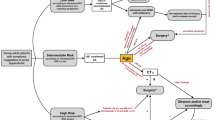Abstract
Background
Intussusception, a common cause of bowel obstruction in young children, is primarily treated with air enema reduction. There is little literature comparing the safety and efficacy of air reduction without or with a rectal balloon.
Objective
To determine the safety and efficacy of a rectal balloon seal in air enema reduction.
Materials and methods
We retrospectively reviewed the records of children who underwent air reduction for ileocolic or ileo-ileocolic intussusception over an 8-year period. We sorted data from 566 children according to whether a rectal balloon was used in the reduction, and further sorted them by type and experience level of the practitioner. Using logistic regression analyses, we identified risk factors for iatrogenic bowel perforation or failed reduction.
Results
Significant associations with bowel perforation included balloon use (P=0.038), age <1 year (P<0.0001), and attending physician’s level of experience <5 years (P=0.043). Younger age was associated with both perforation (P<0.0001) and procedural failure (P=0.001). The risk-adjusted predicted probability of perforation decreased with age, approaching zero by 10 months regardless of balloon use. For cases without bowel resection, the risk-adjusted predicted probability of failure decreased toward zero by 30 months with balloon use, while remaining constant at 3–12% regardless of age when not using a balloon.
Conclusion
The likelihood of a successful air reduction might be safely increased by using an inflated rectal balloon in children older than 9 months. Use of a balloon in younger infants is associated with a higher risk of iatrogenic bowel injury.



Similar content being viewed by others
Change history
25 October 2018
The original version on this paper contained an error. The names of M. John Hicks and R. Paul Guillerman, though correctly appeared in the published version, are incorrectly displayed in indexing sites.
References
Applegate KE, Strouse PJ, Crisci KL et al (2011) ACR-SPR practice guideline for the performance of pediatric fluoroscopic contrast enema examinations. American College of Radiology. https://www.acr.org/-/media/ACR/Files/Practice-Parameters/FluourConEnema-Ped.pdf. Accessed 17 April 2018
Davis CF, McCabe AJ, Raine PAM (2003) The ins and outs of intussusception: history and management over the past fifty years. J Pediatr Surg 38:60–64
Gu L, Alton DJ, Daneman A et al (1988) Intussusception reduction in children by rectal insufflations of air. AJR Am J Roentgenol 150:1345–1348
Daneman A, Navarro O (2004) Intussusception. Part 2: an update on the evolution of management. Pediatr Radiol 34:97–108
Samad L, Marven S, El Bashir H et al (2013) Prospective surveillance study of the management of intussusception in UK and Irish infants. Br J Surg 99:411–415
del-Pozo G, Albillos JC, Tejedor D et al (1999) Intussusception in children: current concepts in diagnosis and enema reduction. Radiographics 19:299–319
Ekenze SO, Mgbor SO (2011) Childhood intussusception: the implications of delayed presentation. Afr J Paediatr Surg 8:15–18
Tareen F, Ryan S, Avanzini S et al (2011) Does the length of the history influence the outcome of pneumatic reduction of intussusception in children? Pediatr Surg Int 27:587–589
Sargent MA, Wilson BPM (1991) Are hydrostatic and pneumatic methods of intussusception reduction comparable? Pediatr Radiol 21:346–349
Phelan E, de Campo JF, Malecky G (1988) Comparison of oxygen and barium reduction of ileocolic intussusception. AJR Am J Roentgenol 150:1349–1352
Sadigh G, Zou KH, Razavi SA et al (2015) Meta-analysis of air versus liquid enema for intussusception reduction in children. AJR Am J Roentgenol 205:W542–W549
Stein-Wexler R, O’Connor R, Daldrup-Link H et al (2015) Current methods for reducing intussusception: survey results. Pediatr Radiol 45:667–674
Kaplan SL, Magill D, Felice MA et al (2017) Intussusception reduction: effect of air vs. liquid enema on radiation dose. Pediatr Radiol 47:1471–1476
Bekdash B, Marven SS, Sprigg A (2013) Reduction of intussusception: defining a better index of successful non-operative treatment. Pediatr Radiol 43:649–656
Betz BW, Hagedorn JE, Guikema JS et al (2013) Therapeutic enema for pediatric ileocolic intussusception: using a balloon catheter improves efficacy. Emerg Radiol 20:385–391
Fallon SC, Lopez ME, Zhang W et al (2013) Risk factors for surgery in pediatric intussusception in the era of pneumatic reduction. J Pediatr Surg 48:1032–1036
Fallon SC, Kim ES, Naik-Mathuria BJ et al (2013) Needle decompression to avoid tension pneumoperitoneum and hemodynamic compromise after pneumatic reduction of pediatric intussusception. Pediatr Radiol 43:662–667
Daneman A, Alton DJ, Ein S et al (1995) Perforation during attempted intussusception reduction in children — a comparison of perforation with barium and air. Pediatr Radiol 25:81–88
Maoate K, Beasley SW (1998) Perforation during gas reduction of intussusception. Pediatr Surg Int 14:168–170
Haber HP, Stern M (2000) Intestinal ultrasonography in children and young adults: bowel wall thickness is age dependent. J Ultrasound Med 19:315–321
Shiels WE II, Kirks DR, Keller GL et al (1993) Colonic perforation by air and liquid enemas: comparison study in young pigs. AJR Am J Roentgenol 160:931–935
Kao SCS, Franken Jr EA (1995) Nonoperative treatment of simple meconium ileus: a survey of the Society for Pediatric Radiology. Pediatr Radiol 25:97–100
Nelson JA, Daiels AU, Dodds WJ (1979) Rectal balloons: complications, causes, and recommendations. Investig Radiol 14:48–59
Dodds WJ Stewart ET, James A (1980) Rectal balloon catheters and the barium enema examination. Gastroint Radiol 5:277–284
Author information
Authors and Affiliations
Corresponding author
Ethics declarations
Conflicts of interest
None
Rights and permissions
About this article
Cite this article
Golriz, F., Cassady, C.I., Bales, B. et al. Comparative safety and efficacy of balloon use in air enema reduction for pediatric intussusception. Pediatr Radiol 48, 1423–1431 (2018). https://doi.org/10.1007/s00247-018-4156-2
Received:
Revised:
Accepted:
Published:
Issue Date:
DOI: https://doi.org/10.1007/s00247-018-4156-2




